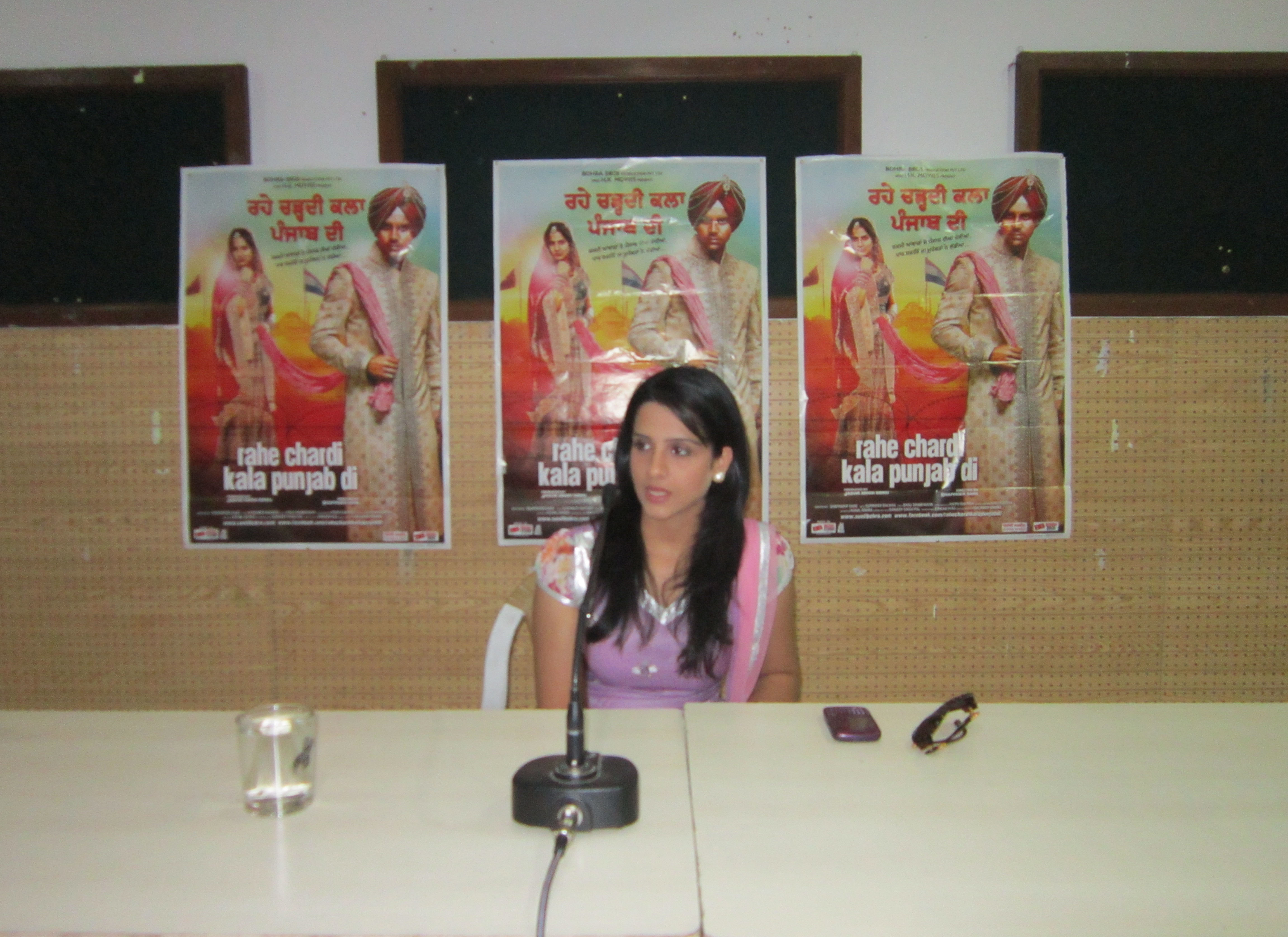Disclaimer: this post is the result of the sole opinions of a visiting Westerner, and should not be taken as an insult to those who know otherwise about the situations and facts I have mentioned. In fact, I would really appreciate hearing other opinions on this topic, so please do get in touch if you feel you have something significant to help with my knowledge on this matter.
The photographers have been waiting for a while when the woman in the pink sari finally strides up the aisle. She skirts the corner of the table neatly, settling herself down in the centre seat. The two chairs on either side of her are empty. She sits at the table alone.
The three identical film posters behind her show a man and a woman; he is in the forefront, while she hides demurely in the back. I’m not sure how many films this woman has acted in, but the casting agents have clearly got her real personality all wrong. Far from being shy and retiring, she’s handling her own press conference.
Solo.
Which, while highly impressive, is something I simply haven’t seen so far in India.
Prabhleen Sandhu is at the Chandigarh Press Club on an oven-bakingly hot Friday lunchtime to talk about her latest film.
While the rapid fire questions between press and actress unfold in incomprehensible Hindi, I look at the press notes and discover that the film is about the ‘girl child’ situation. My interest is piqued: this is a phrase I’ve heard a few times since arriving inIndia, and is clearly a topic under much focus and discussion.
Type the phrase on Google and you’ll see immediately what I mean. ‘Girl child’ is synonymous with the danger of being female in today’s India, where a woman can be beaten or killed by her in-laws for suspected cheating, where girls often miss out on education and respect in the gender bias, and where foetuses are aborted on the grounds that they are female. Luckily, there is a large supporting movement who make it their focus to highlight the problems the ‘girl child’ faces – and this film seems to be part of it.
Prableen is her own woman: strong, confident, and authoritative. There is no visible mark of repression or fear in her attitude. She’s grown up as an Indian female, and come out the other side. She tells reporters, in a moment of English, that her parents have always supported her, despite being initially hesitant to allow their daughter to enter the Indian film industry. And this is when I hear the crucial word: ‘parents’.
For Indian families, the birth of a girl has historically spelled out a wealth of problems. While a son was expected to carry on the family name and look after aged relatives, a daughter meant the eventual loss of a child and the necessary provision of a dowry. Although some of these issues are now obsolete (dowries are banned and retirement homes exist), girls are still thought of as the lesser sex.
But this actress had parents who were happy they had a daughter, and their belief in her prompted a sense of confidence and independence, which is something that many Indian families do not instill in their daughters’ minds.
I don’t know the family history of this woman, but have a good insight into that of my host, Narvijay. Like many Indians, he has just one child – a daughter of 16, whom he loves as much as any parent should. Unlike many Indians, he has chosen to adopt – verbally, at least – another two girls into his family; my cousin, Milli, who he met three years ago, and me, who he’s known for three weeks.
By making his gesture a public one, Narvijay has made the huge statement that he fully supports and respects girls and women, both in India and abroad. Moreover, he respects their right to simply exist, as females, in a world that often still values men first. So much so, in fact, that women are prepared to take excess action to make sure they only ever give birth to sons, no matter how much it costs them.
*
Foeticide is not a word I use back in England. It’s not one I hear regularly, either; we would normally phrase the act it describes as ‘abortion’ – which, in theory, is what it is. Except female foeticide hangs on one crucial point; that the woman choosing to terminate the life of her unborn baby is doing so specifically because she already knows she is carrying a girl.
Unfortunately, female foeticide is still a really big problem in India. Despite many people I’ve talked to trying to persuade me that it’s on the decline, they are still living in a country where “an Indian girl child aged 1-5 years is 75% more likely to die than an Indian boy, making this the worst gender differential in child mortality for any country in the world”. Coming from the West, where finding out a baby’s sex is normally only to choose the paint colour for the nursery, seeing a hatred for unborn girls at such close quarters is a bit of a shock.
Now, I’ve never proclaimed to be a staunch feminist, but I definitely stand by my fellow women, and I think I’ve always taken my freedom for granted. The ability to travel by myself and take responsibility for my own actions is something very important to me, and I’m quickly discovering that in India it’s something of a paradox; Indians seem both in awe and in confusion about what I’m doing. In my current situation as a surrogate daughter to the man who’s been offering me his home for the last three weeks, I’ve seen how Indian people react to a solo female traveling through their country. At the same time as a journalist asks me, ‘how do your family cope with you being so far away from home?’, my host worries about me walking down the street outside his house alone.
I know I’m in a very different society here – and it’s one that women have a very complex role within. They are protected by their families and elders from the moment they’re born, but at the time of marriage they disappear into their husband’s family home – and are often not educated, for this very reason. Reading a post from The Shooting Star recently affirmed this when, on a trip to a remote Uttarakhand village, this solo Indian travel blogger met a young woman with six children – four of whom were female.
“I immediately understand why the number (of children) went that high, and my new friend confirms my hunch by explaining how her husband thinks it’s pointless to spend money educating daughters because “they will marry and leave the house anyway”. She confesses that for that reason, her first daughter never went to school. As I contemplate what to say, she breaks into a proud smile; she has been investing all her earnings since she started working, in the education of the rest of the girls, who have promised to look after her when she grows old. I marvel at the fifteen-year-old who must’ve come to live with her new family without ever meeting them before, and borne kids as early as seventeen, when I was just finishing school.”
Of course, this behaviour is much more common within the villages of India, and it’s very different in the cities, where girls do get an education, and don’t have to be married off at 15. This week, I visited the Punjab University in Chandigarh with my jogging buddy, and he informed me how the student halls of residence work over here. There are two hostels, split by gender; the girls have a curfew of 9.30pm when the building is locked, and they have to sign in or out with a registrar. Basically a ‘come home early, or don’t come home at all’ kind of thing. The boys have no such register, curfew or lockup – they are also allowed cars on campus, while girls are not, meaning they have to fend for themselves with autos and taxis – or other boys’ cars. On the one hand, it’s wonderful that girls are going to university, that their families allow them an education, and that the government provides them with one. But surely it’s a backward step to let them study and also inhibit their independence?
I guess the proof is in the pudding. A lot of the women I’ve met here in Chandigarh are well educated, passionate about their careers in music, journalism, and media, and certain of their goals in life; to become successful, independent, and proud of themselves. Which I respect totally, and long may it continue.
But these women are still living in an environment rife with challenges to overcome. They have to protest against the Haryana government, who say that women wearing jeans to work in their offices is‘indecent’, and announces that they must wear salwar kameez and saris instead – while men can trudge to work in a shirt and trousers. They have to combat India’s plan to raise the age of legal consent from 16 to 18 – a regressive step which will surely prompt more abortions, more secretive behaviour from the teenage generation, and even less open conversation between parents and their children about safe sex. And they have to face the growing popularity of hymen reconstruction surgery in India, with over 100 cases a month in Chandigarh and the surrounding area – popular because it is deemed ‘virginity restoration’, and provides a solution to inquisitive in-laws demanding to know why no blood was shed on the wedding night, even if the bride was a virgin to begin with. Seriously.
With all these problems nipping at their heels, its a testament to Indian women that they’ve come so far already. But I can still see a long struggle ahead. I just hope they keep it up until there is no more doubt that Indian women can easily match up to their male counterparts – and overtake them, too.





3 Comments
Ceri
May 20, 2012 at 6:39 pmWow, thank you for this post, Flora. It’s always an eye opener to be reminded of the situations in other countries. This reminds me a lot about what’s happening in China with girls. And I actually do remember watching a documentary about this subject in India and, at one point, they found a large quarry outside of a city filled with dead baby girls. Parents had come and just thrown their daughters down there because of the pressures of the dowry and raising a girl. So sad.
Download Working Battle Camp Cheat
March 13, 2014 at 11:12 amHey very nice web-site! Gentleman. Beautiful. Excellent. Let me bookmark your website plus go ahead and take nourishes in addition? I am just content to get numerous valuable data below from the placed, we would like come up with more techniques in this regard, appreciation for revealing.
Yanz
December 8, 2017 at 7:32 amDowries whilst illegal still exist and are often used as a way to control and abuse women, not only from her husband but from the extended family as well. For the first time in Australia dowry abuse is now included in domestic violence law as many women who have moved here from India for arranged marriages have been abused because their family is disappointed with the dowry amount. In one instance a women went to the police to talk about dowry abuse and the police wrote down they they were arguing over Indian currency therefore they didn’t take her seriously, then she was murdered.